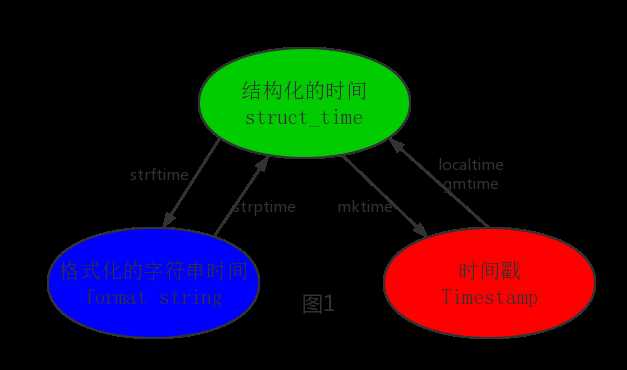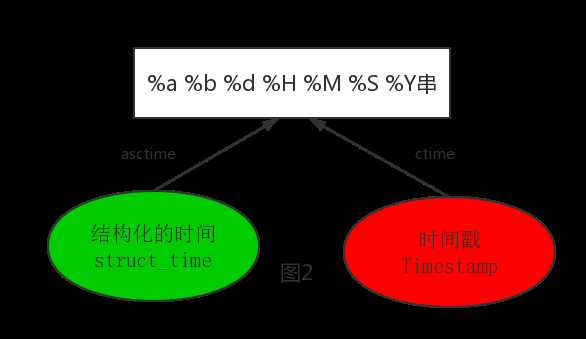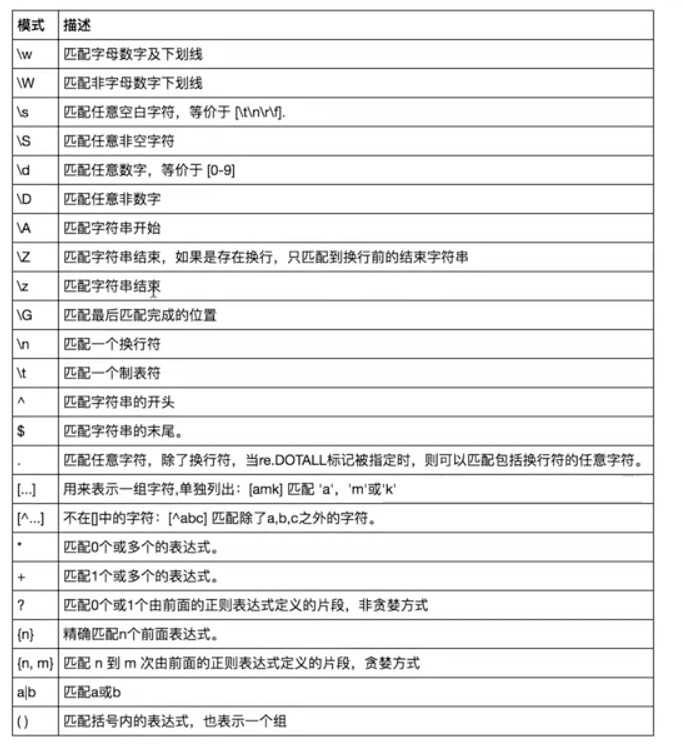标签:c89 end 原理 com 编程 完全 系统 mha 爬虫
在Python中,通常有这几种方式来表示时间:
1 import time
2 #--------------------------我们先以当前时间为准,让大家快速认识三种形式的时间
3 print(time.time()) # 时间戳:1487130156.419527
4 print(time.strftime("%Y-%m-%d %X")) #格式化的时间字符串:‘2017-02-15 11:40:53‘
5
6 print(time.localtime()) #本地时区的struct_time
7 print(time.gmtime()) #UTC时区的struct_time
 格式化字符串的时间格式
格式化字符串的时间格式
其中计算机认识的时间只能是‘时间戳‘格式,而程序员可处理的或者说人类能看懂的时间有: ‘格式化的时间字符串‘,‘结构化的时间‘ ,于是有了下图的转换关系

1 #--------------------------按图1转换时间
2 # localtime([secs])
3 # 将一个时间戳转换为当前时区的struct_time。secs参数未提供,则以当前时间为准。
4 time.localtime()
5 time.localtime(1473525444.037215)
6
7 # gmtime([secs]) 和localtime()方法类似,gmtime()方法是将一个时间戳转换为UTC时区(0时区)的struct_time。
8
9 # mktime(t) : 将一个struct_time转化为时间戳。
10 print(time.mktime(time.localtime()))#1473525749.0
11
12
13 # strftime(format[, t]) : 把一个代表时间的元组或者struct_time(如由time.localtime()和
14 # time.gmtime()返回)转化为格式化的时间字符串。如果t未指定,将传入time.localtime()。如果元组中任何一个
15 # 元素越界,ValueError的错误将会被抛出。
16 print(time.strftime("%Y-%m-%d %X", time.localtime()))#2016-09-11 00:49:56
17
18 # time.strptime(string[, format])
19 # 把一个格式化时间字符串转化为struct_time。实际上它和strftime()是逆操作。
20 print(time.strptime(‘2011-05-05 16:37:06‘, ‘%Y-%m-%d %X‘))
21 #time.struct_time(tm_year=2011, tm_mon=5, tm_mday=5, tm_hour=16, tm_min=37, tm_sec=6,
22 # tm_wday=3, tm_yday=125, tm_isdst=-1)
23 #在这个函数中,format默认为:"%a %b %d %H:%M:%S %Y"。

1 #--------------------------按图2转换时间 2 # asctime([t]) : 把一个表示时间的元组或者struct_time表示为这种形式:‘Sun Jun 20 23:21:05 1993‘。 3 # 如果没有参数,将会将time.localtime()作为参数传入。 4 print(time.asctime())#Sun Sep 11 00:43:43 2016 5 6 # ctime([secs]) : 把一个时间戳(按秒计算的浮点数)转化为time.asctime()的形式。如果参数未给或者为 7 # None的时候,将会默认time.time()为参数。它的作用相当于time.asctime(time.localtime(secs))。 8 print(time.ctime()) # Sun Sep 11 00:46:38 2016 9 print(time.ctime(time.time())) # Sun Sep 11 00:46:38 2016
1 #--------------------------其他用法 2 # sleep(secs) 3 # 线程推迟指定的时间运行,单位为秒。
 datetime模块
datetime模块1 import random 2 3 print(random.random())#(0,1)----float 大于0且小于1之间的小数 4 5 print(random.randint(1,3)) #[1,3] 大于等于1且小于等于3之间的整数 6 7 print(random.randrange(1,3)) #[1,3) 大于等于1且小于3之间的整数 8 9 print(random.choice([1,‘23‘,[4,5]]))#1或者23或者[4,5] 10 11 print(random.sample([1,‘23‘,[4,5]],2))#列表元素任意2个组合 12 13 print(random.uniform(1,3))#大于1小于3的小数,如1.927109612082716 14 15 16 item=[1,3,5,7,9] 17 random.shuffle(item) #打乱item的顺序,相当于"洗牌" 18 print(item)
 生成随机验证码
生成随机验证码os模块是与操作系统交互的一个接口
 View Code
View Code在Linux和Mac平台上,该函数会原样返回path,在windows平台上会将路径中所有字符转换为小写,并将所有斜杠转换为饭斜杠。 >>> os.path.normcase(‘c:/windows\\system32\\‘) ‘c:\\windows\\system32\\‘ 规范化路径,如..和/ >>> os.path.normpath(‘c://windows\\System32\\../Temp/‘) ‘c:\\windows\\Temp‘ >>> a=‘/Users/jieli/test1/\\\a1/\\\\aa.py/../..‘ >>> print(os.path.normpath(a)) /Users/jieli/test1
os路径处理
#方式一:推荐使用
import os
#具体应用
import os,sys
possible_topdir = os.path.normpath(os.path.join(
os.path.abspath(__file__),
os.pardir, #上一级
os.pardir,
os.pardir
))
sys.path.insert(0,possible_topdir)
#方式二:不推荐使用
os.path.dirname(os.path.dirname(os.path.dirname(os.path.abspath(__file__))))
1 sys.argv 命令行参数List,第一个元素是程序本身路径 2 sys.exit(n) 退出程序,正常退出时exit(0) 3 sys.version 获取Python解释程序的版本信息 4 sys.maxint 最大的Int值 5 sys.path 返回模块的搜索路径,初始化时使用PYTHONPATH环境变量的值 6 sys.platform 返回操作系统平台名称
 打印进度条
打印进度条高级的 文件、文件夹、压缩包 处理模块
shutil.copyfileobj(fsrc, fdst[, length])
将文件内容拷贝到另一个文件中
1 import shutil 2 3 shutil.copyfileobj(open(‘old.xml‘,‘r‘), open(‘new.xml‘, ‘w‘))
shutil.copyfile(src, dst)
拷贝文件
1 shutil.copyfile(‘f1.log‘, ‘f2.log‘) #目标文件无需存在
shutil.copymode(src, dst)
仅拷贝权限。内容、组、用户均不变
1 shutil.copymode(‘f1.log‘, ‘f2.log‘) #目标文件必须存在
shutil.copystat(src, dst)
仅拷贝状态的信息,包括:mode bits, atime, mtime, flags
1 shutil.copystat(‘f1.log‘, ‘f2.log‘) #目标文件必须存在
shutil.copy(src, dst)
拷贝文件和权限
1 import shutil 2 3 shutil.copy(‘f1.log‘, ‘f2.log‘)
shutil.copy2(src, dst)
拷贝文件和状态信息
1 import shutil 2 3 shutil.copy2(‘f1.log‘, ‘f2.log‘)
shutil.ignore_patterns(*patterns)
shutil.copytree(src, dst, symlinks=False, ignore=None)
递归的去拷贝文件夹
1 import shutil 2 3 shutil.copytree(‘folder1‘, ‘folder2‘, ignore=shutil.ignore_patterns(‘*.pyc‘, ‘tmp*‘)) #目标目录不能存在,注意对folder2目录父级目录要有可写权限,ignore的意思是排除
 拷贝软连接
拷贝软连接
shutil.rmtree(path[, ignore_errors[, onerror]])
递归的去删除文件
1 import shutil 2 3 shutil.rmtree(‘folder1‘)
shutil.move(src, dst)
递归的去移动文件,它类似mv命令,其实就是重命名。
1 import shutil 2 3 shutil.move(‘folder1‘, ‘folder3‘)
shutil.make_archive(base_name, format,...)
创建压缩包并返回文件路径,例如:zip、tar
创建压缩包并返回文件路径,例如:zip、tar
1 #将 /data 下的文件打包放置当前程序目录
2 import shutil
3 ret = shutil.make_archive("data_bak", ‘gztar‘, root_dir=‘/data‘)
4
5
6 #将 /data下的文件打包放置 /tmp/目录
7 import shutil
8 ret = shutil.make_archive("/tmp/data_bak", ‘gztar‘, root_dir=‘/data‘)
shutil 对压缩包的处理是调用 ZipFile 和 TarFile 两个模块来进行的,详细:
 zipfile压缩解压缩
zipfile压缩解压缩 tarfile压缩解压缩
tarfile压缩解压缩之前我们学习过用eval内置方法可以将一个字符串转成python对象,不过,eval方法是有局限性的,对于普通的数据类型,json.loads和eval都能用,但遇到特殊类型的时候,eval就不管用了,所以eval的重点还是通常用来执行一个字符串表达式,并返回表达式的值。
1 import json 2 x="[null,true,false,1]" 3 print(eval(x)) #报错,无法解析null类型,而json就可以 4 print(json.loads(x))
什么是序列化?
我们把对象(变量)从内存中变成可存储或传输的过程称之为序列化,在Python中叫pickling,在其他语言中也被称之为serialization,marshalling,flattening等等,都是一个意思。
为什么要序列化?
1:持久保存状态
需知一个软件/程序的执行就在处理一系列状态的变化,在编程语言中,‘状态‘会以各种各样有结构的数据类型(也可简单的理解为变量)的形式被保存在内存中。
内存是无法永久保存数据的,当程序运行了一段时间,我们断电或者重启程序,内存中关于这个程序的之前一段时间的数据(有结构)都被清空了。
在断电或重启程序之前将程序当前内存中所有的数据都保存下来(保存到文件中),以便于下次程序执行能够从文件中载入之前的数据,然后继续执行,这就是序列化。
具体的来说,你玩使命召唤闯到了第13关,你保存游戏状态,关机走人,下次再玩,还能从上次的位置开始继续闯关。或如,虚拟机状态的挂起等。
2:跨平台数据交互
序列化之后,不仅可以把序列化后的内容写入磁盘,还可以通过网络传输到别的机器上,如果收发的双方约定好实用一种序列化的格式,那么便打破了平台/语言差异化带来的限制,实现了跨平台数据交互。
反过来,把变量内容从序列化的对象重新读到内存里称之为反序列化,即unpickling。
如何序列化之json和pickle:
json
如果我们要在不同的编程语言之间传递对象,就必须把对象序列化为标准格式,比如XML,但更好的方法是序列化为JSON,因为JSON表示出来就是一个字符串,可以被所有语言读取,也可以方便地存储到磁盘或者通过网络传输。JSON不仅是标准格式,并且比XML更快,而且可以直接在Web页面中读取,非常方便。
JSON表示的对象就是标准的JavaScript语言的对象,JSON和Python内置的数据类型对应如下:


1 import json
2
3 dic={‘name‘:‘alvin‘,‘age‘:23,‘sex‘:‘male‘}
4 print(type(dic))#<class ‘dict‘>
5
6 j=json.dumps(dic)
7 print(type(j))#<class ‘str‘>
8
9
10 f=open(‘序列化对象‘,‘w‘)
11 f.write(j) #-------------------等价于json.dump(dic,f)
12 f.close()
13 #-----------------------------反序列化<br>
14 import json
15 f=open(‘序列化对象‘)
16 data=json.loads(f.read())# 等价于data=json.load(f)
 注意点
注意点pickle

1 import pickle
2
3 dic={‘name‘:‘alvin‘,‘age‘:23,‘sex‘:‘male‘}
4
5 print(type(dic))#<class ‘dict‘>
6
7 j=pickle.dumps(dic)
8 print(type(j))#<class ‘bytes‘>
9
10
11 f=open(‘序列化对象_pickle‘,‘wb‘)#注意是w是写入str,wb是写入bytes,j是‘bytes‘
12 f.write(j) #-------------------等价于pickle.dump(dic,f)
13
14 f.close()
15 #-------------------------反序列化
16 import pickle
17 f=open(‘序列化对象_pickle‘,‘rb‘)
18
19 data=pickle.loads(f.read())# 等价于data=pickle.load(f)
20
21
22 print(data[‘age‘])
Pickle的问题和所有其他编程语言特有的序列化问题一样,就是它只能用于Python,并且可能不同版本的Python彼此都不兼容,因此,只能用Pickle保存那些不重要的数据,不能成功地反序列化也没关系。
shelve模块比pickle模块简单,只有一个open函数,返回类似字典的对象,可读可写;key必须为字符串,而值可以是python所支持的数据类型
import shelve
f=shelve.open(r‘sheve.txt‘)
# f[‘stu1_info‘]={‘name‘:‘egon‘,‘age‘:18,‘hobby‘:[‘piao‘,‘smoking‘,‘drinking‘]}
# f[‘stu2_info‘]={‘name‘:‘gangdan‘,‘age‘:53}
# f[‘school_info‘]={‘website‘:‘http://www.pypy.org‘,‘city‘:‘beijing‘}
print(f[‘stu1_info‘][‘hobby‘])
f.close()
xml是实现不同语言或程序之间进行数据交换的协议,跟json差不多,但json使用起来更简单,不过,古时候,在json还没诞生的黑暗年代,大家只能选择用xml呀,至今很多传统公司如金融行业的很多系统的接口还主要是xml。
xml的格式如下,就是通过<>节点来区别数据结构的:
 xml数据
xml数据xml协议在各个语言里的都 是支持的,在python中可以用以下模块操作xml:
# print(root.iter(‘year‘)) #全文搜索 # print(root.find(‘country‘)) #在root的子节点找,只找一个 # print(root.findall(‘country‘)) #在root的子节点找,找所有
 View Code
View Code#在country内添加(append)节点year2
import xml.etree.ElementTree as ET
tree = ET.parse("a.xml")
root=tree.getroot()
for country in root.findall(‘country‘):
for year in country.findall(‘year‘):
if int(year.text) > 2000:
year2=ET.Element(‘year2‘)
year2.text=‘新年‘
year2.attrib={‘update‘:‘yes‘}
country.append(year2) #往country节点下添加子节点
tree.write(‘a.xml.swap‘)
自己创建xml文档:
 View Code
View Code配置文件如下:
# 注释1 ; 注释2 [section1] k1 = v1 k2:v2 user=egon age=18 is_admin=true salary=31
[section2] k1 = v1
读取
import configparser config=configparser.ConfigParser() config.read(‘a.cfg‘) #查看所有的标题 res=config.sections() #[‘section1‘, ‘section2‘] print(res) #查看标题section1下所有key=value的key options=config.options(‘section1‘) print(options) #[‘k1‘, ‘k2‘, ‘user‘, ‘age‘, ‘is_admin‘, ‘salary‘] #查看标题section1下所有key=value的(key,value)格式 item_list=config.items(‘section1‘) print(item_list) #[(‘k1‘, ‘v1‘), (‘k2‘, ‘v2‘), (‘user‘, ‘egon‘), (‘age‘, ‘18‘), (‘is_admin‘, ‘true‘), (‘salary‘, ‘31‘)] #查看标题section1下user的值=>字符串格式 val=config.get(‘section1‘,‘user‘) print(val) #egon #查看标题section1下age的值=>整数格式 val1=config.getint(‘section1‘,‘age‘) print(val1) #18 #查看标题section1下is_admin的值=>布尔值格式 val2=config.getboolean(‘section1‘,‘is_admin‘) print(val2) #True #查看标题section1下salary的值=>浮点型格式 val3=config.getfloat(‘section1‘,‘salary‘) print(val3) #31.0
改写
import configparser config=configparser.ConfigParser() config.read(‘a.cfg‘,encoding=‘utf-8‘) #删除整个标题section2 config.remove_section(‘section2‘) #删除标题section1下的某个k1和k2 config.remove_option(‘section1‘,‘k1‘) config.remove_option(‘section1‘,‘k2‘) #判断是否存在某个标题 print(config.has_section(‘section1‘)) #判断标题section1下是否有user print(config.has_option(‘section1‘,‘‘)) #添加一个标题 config.add_section(‘egon‘) #在标题egon下添加name=egon,age=18的配置 config.set(‘egon‘,‘name‘,‘egon‘) config.set(‘egon‘,‘age‘,18) #报错,必须是字符串 #最后将修改的内容写入文件,完成最终的修改 config.write(open(‘a.cfg‘,‘w‘))
 基于上述方法添加一个ini文档
基于上述方法添加一个ini文档hash:一种算法 ,3.x里代替了md5模块和sha模块,主要提供 SHA1, SHA224, SHA256, SHA384, SHA512 ,MD5 算法
三个特点:
1.内容相同则hash运算结果相同,内容稍微改变则hash值则变
2.不可逆推
3.相同算法:无论校验多长的数据,得到的哈希值长度固定。
1 import hashlib 2 3 m=hashlib.md5()# m=hashlib.sha256() 4 5 m.update(‘hello‘.encode(‘utf8‘)) 6 print(m.hexdigest()) #5d41402abc4b2a76b9719d911017c592 7 8 m.update(‘alvin‘.encode(‘utf8‘)) 9 10 print(m.hexdigest()) #92a7e713c30abbb0319fa07da2a5c4af 11 12 m2=hashlib.md5() 13 m2.update(‘helloalvin‘.encode(‘utf8‘)) 14 print(m2.hexdigest()) #92a7e713c30abbb0319fa07da2a5c4af 15 16 ‘‘‘ 17 注意:把一段很长的数据update多次,与一次update这段长数据,得到的结果一样 18 但是update多次为校验大文件提供了可能。 19 ‘‘‘
以上加密算法虽然依然非常厉害,但时候存在缺陷,即:通过撞库可以反解。所以,有必要对加密算法中添加自定义key再来做加密。
1 import hashlib 2 3 # ######## 256 ######## 4 5 hash = hashlib.sha256(‘898oaFs09f‘.encode(‘utf8‘)) 6 hash.update(‘alvin‘.encode(‘utf8‘)) 7 print (hash.hexdigest())#e79e68f070cdedcfe63eaf1a2e92c83b4cfb1b5c6bc452d214c1b7e77cdfd1c7
 模拟撞库破解密码
模拟撞库破解密码
python 还有一个 hmac 模块,它内部对我们创建 key 和 内容 进行进一步的处理然后再加密:
1 import hmac 2 h = hmac.new(‘alvin‘.encode(‘utf8‘)) 3 h.update(‘hello‘.encode(‘utf8‘)) 4 print (h.hexdigest())#320df9832eab4c038b6c1d7ed73a5940
 注意!注意!注意
注意!注意!注意
1 import subprocess 2 3 ‘‘‘ 4 sh-3.2# ls /Users/egon/Desktop |grep txt$ 5 mysql.txt 6 tt.txt 7 事物.txt 8 ‘‘‘ 9 10 res1=subprocess.Popen(‘ls /Users/jieli/Desktop‘,shell=True,stdout=subprocess.PIPE) 11 res=subprocess.Popen(‘grep txt$‘,shell=True,stdin=res1.stdout, 12 stdout=subprocess.PIPE) 13 14 print(res.stdout.read().decode(‘utf-8‘)) 15 16 17 #等同于上面,但是上面的优势在于,一个数据流可以和另外一个数据流交互,可以通过爬虫得到结果然后交给grep 18 res1=subprocess.Popen(‘ls /Users/jieli/Desktop |grep txt$‘,shell=True,stdout=subprocess.PIPE) 19 print(res1.stdout.read().decode(‘utf-8‘)) 20 21 22 #windows下: 23 # dir | findstr ‘test*‘ 24 # dir | findstr ‘txt$‘ 25 import subprocess 26 res1=subprocess.Popen(r‘dir C:\Users\Administrator\PycharmProjects\test\函数备课‘,shell=True,stdout=subprocess.PIPE) 27 res=subprocess.Popen(‘findstr test*‘,shell=True,stdin=res1.stdout, 28 stdout=subprocess.PIPE) 29 30 print(res.stdout.read().decode(‘gbk‘)) #subprocess使用当前系统默认编码,得到结果为bytes类型,在windows下需要用gbk解码
一 日志级别
CRITICAL = 50 #FATAL = CRITICAL ERROR = 40 WARNING = 30 #WARN = WARNING INFO = 20 DEBUG = 10 NOTSET = 0 #不设置
二 默认级别为warning,默认打印到终端
import logging logging.debug(‘调试debug‘) logging.info(‘消息info‘) logging.warning(‘警告warn‘) logging.error(‘错误error‘) logging.critical(‘严重critical‘) ‘‘‘ WARNING:root:警告warn ERROR:root:错误error CRITICAL:root:严重critical ‘‘‘
三 为logging模块指定全局配置,针对所有logger有效,控制打印到文件中
 logging.basicConfig()
logging.basicConfig() View Code
View Code四 logging模块的Formatter,Handler,Logger,Filter对象
原理图:https://pan.baidu.com/s/1skWyTT7
#logger:产生日志的对象 #Filter:过滤日志的对象 #Handler:接收日志然后控制打印到不同的地方,FileHandler用来打印到文件中,StreamHandler用来打印到终端 #Formatter对象:可以定制不同的日志格式对象,然后绑定给不同的Handler对象使用,以此来控制不同的Handler的日志格式
 View Code
View Code五 Logger与Handler的级别
logger是第一级过滤,然后才能到handler,我们可以给logger和handler同时设置level,但是需要注意的是
 重要,重要,重要!!!
重要,重要,重要!!!六 Logger的继承(了解)
 View Code
View Code七 应用
 logging配置文件
logging配置文件 使用
使用 !!!关于如何拿到logger对象的详细解释!!!
!!!关于如何拿到logger对象的详细解释!!!另外一个django的配置,瞄一眼就可以,跟上面的一样
 View Code
View Code一:什么是正则?
正则就是用一些具有特殊含义的符号组合到一起(称为正则表达式)来描述字符或者字符串的方法。或者说:正则就是用来描述一类事物的规则。(在Python中)它内嵌在Python中,并通过 re 模块实现。正则表达式模式被编译成一系列的字节码,然后由用 C 编写的匹配引擎执行。
生活中处处都是正则:
比如我们描述:4条腿
你可能会想到的是四条腿的动物或者桌子,椅子等
继续描述:4条腿,活的
就只剩下四条腿的动物这一类了
二:常用匹配模式(元字符)
http://blog.csdn.net/yufenghyc/article/details/51078107

# =================================匹配模式=================================
#一对一的匹配
# ‘hello‘.replace(old,new)
# ‘hello‘.find(‘pattern‘)
#正则匹配
import re
#\w与\W
print(re.findall(‘\w‘,‘hello egon 123‘)) #[‘h‘, ‘e‘, ‘l‘, ‘l‘, ‘o‘, ‘e‘, ‘g‘, ‘o‘, ‘n‘, ‘1‘, ‘2‘, ‘3‘]
print(re.findall(‘\W‘,‘hello egon 123‘)) #[‘ ‘, ‘ ‘]
#\s与\S
print(re.findall(‘\s‘,‘hello egon 123‘)) #[‘ ‘, ‘ ‘, ‘ ‘, ‘ ‘]
print(re.findall(‘\S‘,‘hello egon 123‘)) #[‘h‘, ‘e‘, ‘l‘, ‘l‘, ‘o‘, ‘e‘, ‘g‘, ‘o‘, ‘n‘, ‘1‘, ‘2‘, ‘3‘]
#\n \t都是空,都可以被\s匹配
print(re.findall(‘\s‘,‘hello \n egon \t 123‘)) #[‘ ‘, ‘\n‘, ‘ ‘, ‘ ‘, ‘\t‘, ‘ ‘]
#\n与\t
print(re.findall(r‘\n‘,‘hello egon \n123‘)) #[‘\n‘]
print(re.findall(r‘\t‘,‘hello egon\t123‘)) #[‘\n‘]
#\d与\D
print(re.findall(‘\d‘,‘hello egon 123‘)) #[‘1‘, ‘2‘, ‘3‘]
print(re.findall(‘\D‘,‘hello egon 123‘)) #[‘h‘, ‘e‘, ‘l‘, ‘l‘, ‘o‘, ‘ ‘, ‘e‘, ‘g‘, ‘o‘, ‘n‘, ‘ ‘]
#\A与\Z
print(re.findall(‘\Ahe‘,‘hello egon 123‘)) #[‘he‘],\A==>^
print(re.findall(‘123\Z‘,‘hello egon 123‘)) #[‘he‘],\Z==>$
#^与$
print(re.findall(‘^h‘,‘hello egon 123‘)) #[‘h‘]
print(re.findall(‘3$‘,‘hello egon 123‘)) #[‘3‘]
# 重复匹配:| . | * | ? | .* | .*? | + | {n,m} |
#.
print(re.findall(‘a.b‘,‘a1b‘)) #[‘a1b‘]
print(re.findall(‘a.b‘,‘a1b a*b a b aaab‘)) #[‘a1b‘, ‘a*b‘, ‘a b‘, ‘aab‘]
print(re.findall(‘a.b‘,‘a\nb‘)) #[]
print(re.findall(‘a.b‘,‘a\nb‘,re.S)) #[‘a\nb‘]
print(re.findall(‘a.b‘,‘a\nb‘,re.DOTALL)) #[‘a\nb‘]同上一条意思一样
#*
print(re.findall(‘ab*‘,‘bbbbbbb‘)) #[]
print(re.findall(‘ab*‘,‘a‘)) #[‘a‘]
print(re.findall(‘ab*‘,‘abbbb‘)) #[‘abbbb‘]
#?
print(re.findall(‘ab?‘,‘a‘)) #[‘a‘]
print(re.findall(‘ab?‘,‘abbb‘)) #[‘ab‘]
#匹配所有包含小数在内的数字
print(re.findall(‘\d+\.?\d*‘,"asdfasdf123as1.13dfa12adsf1asdf3")) #[‘123‘, ‘1.13‘, ‘12‘, ‘1‘, ‘3‘]
#.*默认为贪婪匹配
print(re.findall(‘a.*b‘,‘a1b22222222b‘)) #[‘a1b22222222b‘]
#.*?为非贪婪匹配:推荐使用
print(re.findall(‘a.*?b‘,‘a1b22222222b‘)) #[‘a1b‘]
#+
print(re.findall(‘ab+‘,‘a‘)) #[]
print(re.findall(‘ab+‘,‘abbb‘)) #[‘abbb‘]
#{n,m}
print(re.findall(‘ab{2}‘,‘abbb‘)) #[‘abb‘]
print(re.findall(‘ab{2,4}‘,‘abbb‘)) #[‘abb‘]
print(re.findall(‘ab{1,}‘,‘abbb‘)) #‘ab{1,}‘ ===> ‘ab+‘
print(re.findall(‘ab{0,}‘,‘abbb‘)) #‘ab{0,}‘ ===> ‘ab*‘
#[]
print(re.findall(‘a[1*-]b‘,‘a1b a*b a-b‘)) #[]内的都为普通字符了,且如果-没有被转意的话,应该放到[]的开头或结尾
print(re.findall(‘a[^1*-]b‘,‘a1b a*b a-b a=b‘)) #[]内的^代表的意思是取反,所以结果为[‘a=b‘]
print(re.findall(‘a[0-9]b‘,‘a1b a*b a-b a=b‘)) #[]内的^代表的意思是取反,所以结果为[‘a=b‘]
print(re.findall(‘a[a-z]b‘,‘a1b a*b a-b a=b aeb‘)) #[]内的^代表的意思是取反,所以结果为[‘a=b‘]
print(re.findall(‘a[a-zA-Z]b‘,‘a1b a*b a-b a=b aeb aEb‘)) #[]内的^代表的意思是取反,所以结果为[‘a=b‘]
#\# print(re.findall(‘a\\c‘,‘a\c‘)) #对于正则来说a\\c确实可以匹配到a\c,但是在python解释器读取a\\c时,会发生转义,然后交给re去执行,所以抛出异常
print(re.findall(r‘a\\c‘,‘a\c‘)) #r代表告诉解释器使用rawstring,即原生字符串,把我们正则内的所有符号都当普通字符处理,不要转义
print(re.findall(‘a\\\\c‘,‘a\c‘)) #同上面的意思一样,和上面的结果一样都是[‘a\\c‘]
#():分组
print(re.findall(‘ab+‘,‘ababab123‘)) #[‘ab‘, ‘ab‘, ‘ab‘]
print(re.findall(‘(ab)+123‘,‘ababab123‘)) #[‘ab‘],匹配到末尾的ab123中的ab
print(re.findall(‘(?:ab)+123‘,‘ababab123‘)) #findall的结果不是匹配的全部内容,而是组内的内容,?:可以让结果为匹配的全部内容
#|
print(re.findall(‘compan(?:y|ies)‘,‘Too many companies have gone bankrupt, and the next one is my company‘))
# ===========================re模块提供的方法介绍===========================
import re
#1
print(re.findall(‘e‘,‘alex make love‘) ) #[‘e‘, ‘e‘, ‘e‘],返回所有满足匹配条件的结果,放在列表里
#2
print(re.search(‘e‘,‘alex make love‘).group()) #e,只到找到第一个匹配然后返回一个包含匹配信息的对象,该对象可以通过调用group()方法得到匹配的字符串,如果字符串没有匹配,则返回None。
#3
print(re.match(‘e‘,‘alex make love‘)) #None,同search,不过在字符串开始处进行匹配,完全可以用search+^代替match
#4
print(re.split(‘[ab]‘,‘abcd‘)) #[‘‘, ‘‘, ‘cd‘],先按‘a‘分割得到‘‘和‘bcd‘,再对‘‘和‘bcd‘分别按‘b‘分割
#5
print(‘===>‘,re.sub(‘a‘,‘A‘,‘alex make love‘)) #===> Alex mAke love,不指定n,默认替换所有
print(‘===>‘,re.sub(‘a‘,‘A‘,‘alex make love‘,1)) #===> Alex make love
print(‘===>‘,re.sub(‘a‘,‘A‘,‘alex make love‘,2)) #===> Alex mAke love
print(‘===>‘,re.sub(‘^(\w+)(.*?\s)(\w+)(.*?\s)(\w+)(.*?)$‘,r‘\5\2\3\4\1‘,‘alex make love‘)) #===> love make alex
print(‘===>‘,re.subn(‘a‘,‘A‘,‘alex make love‘)) #===> (‘Alex mAke love‘, 2),结果带有总共替换的个数
#6
obj=re.compile(‘\d{2}‘)
print(obj.search(‘abc123eeee‘).group()) #12
print(obj.findall(‘abc123eeee‘)) #[‘12‘],重用了obj
 补充一
补充一 补充二
补充二#计算器作业参考:http://www.cnblogs.com/wupeiqi/articles/4949995.html expression=‘1-2*((60+2*(-3-40.0/5)*(9-2*5/3+7/3*99/4*2998+10*568/14))-(-4*3)/(16-3*2))‘ content=re.search(‘\(([\-\+\*\/]*\d+\.?\d*)+\)‘,expression).group() #(-3-40.0/5)

#为何同样的表达式search与findall却有不同结果: print(re.search(‘\(([\+\-\*\/]*\d+\.?\d*)+\)‘,"1-12*(60+(-40.35/5)-(-4*3))").group()) #(-40.35/5) print(re.findall(‘\(([\+\-\*\/]*\d+\.?\d*)+\)‘,"1-12*(60+(-40.35/5)-(-4*3))")) #[‘/5‘, ‘*3‘] #看这个例子:(\d)+相当于(\d)(\d)(\d)(\d)...,是一系列分组 print(re.search(‘(\d)+‘,‘123‘).group()) #group的作用是将所有组拼接到一起显示出来 print(re.findall(‘(\d)+‘,‘123‘)) #findall结果是组内的结果,且是最后一个组的结果

#_*_coding:utf-8_*_
__author__ = ‘Linhaifeng‘
#在线调试工具:tool.oschina.net/regex/#
import re
s=‘‘‘
http://www.baidu.com
egon@oldboyedu.com
你好
010-3141
‘‘‘
#最常规匹配
# content=‘Hello 123 456 World_This is a Regex Demo‘
# res=re.match(‘Hello\s\d\d\d\s\d{3}\s\w{10}.*Demo‘,content)
# print(res)
# print(res.group())
# print(res.span())
#泛匹配
# content=‘Hello 123 456 World_This is a Regex Demo‘
# res=re.match(‘^Hello.*Demo‘,content)
# print(res.group())
#匹配目标,获得指定数据
# content=‘Hello 123 456 World_This is a Regex Demo‘
# res=re.match(‘^Hello\s(\d+)\s(\d+)\s.*Demo‘,content)
# print(res.group()) #取所有匹配的内容
# print(res.group(1)) #取匹配的第一个括号内的内容
# print(res.group(2)) #去陪陪的第二个括号内的内容
#贪婪匹配:.*代表匹配尽可能多的字符
# import re
# content=‘Hello 123 456 World_This is a Regex Demo‘
#
# res=re.match(‘^He.*(\d+).*Demo$‘,content)
# print(res.group(1)) #只打印6,因为.*会尽可能多的匹配,然后后面跟至少一个数字
#非贪婪匹配:?匹配尽可能少的字符
# import re
# content=‘Hello 123 456 World_This is a Regex Demo‘
#
# res=re.match(‘^He.*?(\d+).*Demo$‘,content)
# print(res.group(1)) #只打印6,因为.*会尽可能多的匹配,然后后面跟至少一个数字
#匹配模式:.不能匹配换行符
content=‘‘‘Hello 123456 World_This
is a Regex Demo
‘‘‘
# res=re.match(‘He.*?(\d+).*?Demo$‘,content)
# print(res) #输出None
# res=re.match(‘He.*?(\d+).*?Demo$‘,content,re.S) #re.S让.可以匹配换行符
# print(res)
# print(res.group(1))
#转义:
# content=‘price is $5.00‘
# res=re.match(‘price is $5.00‘,content)
# print(res)
#
# res=re.match(‘price is \$5\.00‘,content)
# print(res)
#总结:尽量精简,详细的如下
# 尽量使用泛匹配模式.*
# 尽量使用非贪婪模式:.*?
# 使用括号得到匹配目标:用group(n)去取得结果
# 有换行符就用re.S:修改模式
#re.search:会扫描整个字符串,不会从头开始,找到第一个匹配的结果就会返回
# import re
# content=‘Extra strings Hello 123 456 World_This is a Regex Demo Extra strings‘
#
# res=re.match(‘Hello.*?(\d+).*?Demo‘,content)
# print(res) #输出结果为None
#
# import re
# content=‘Extra strings Hello 123 456 World_This is a Regex Demo Extra strings‘
#
# res=re.search(‘Hello.*?(\d+).*?Demo‘,content) #
# print(res.group(1)) #输出结果为
#re.search:只要一个结果,匹配演练,
import re
content=‘‘‘
<tbody>
<tr id="4766303201494371851675" class="even "><td><div class="hd"><span class="num">1</span><div class="rk "><span class="u-icn u-icn-75"></span></div></div></td><td class="rank"><div class="f-cb"><div class="tt"><a href="/song?id=476630320"><img class="rpic" src="http://p1.music.126.net/Wl7T1LBRhZFg0O26nnR2iQ==/19217264230385030.jpg?param=50y50&quality=100"></a><span data-res-id="476630320" "
# res=re.search(‘<a\shref=.*?<b\stitle="(.*?)".*?b>‘,content)
# print(res.group(1))
#re.findall:找到符合条件的所有结果
# res=re.findall(‘<a\shref=.*?<b\stitle="(.*?)".*?b>‘,content)
# for i in res:
# print(i)
#re.sub:字符串替换
import re
content=‘Extra strings Hello 123 456 World_This is a Regex Demo Extra strings‘
# content=re.sub(‘\d+‘,‘‘,content)
# print(content)
#用\1取得第一个括号的内容
#用法:将123与456换位置
# import re
# content=‘Extra strings Hello 123 456 World_This is a Regex Demo Extra strings‘
#
# # content=re.sub(‘(Extra.*?)(\d+)(\s)(\d+)(.*?strings)‘,r‘\1\4\3\2\5‘,content)
# content=re.sub(‘(\d+)(\s)(\d+)‘,r‘\3\2\1‘,content)
# print(content)
# import re
# content=‘Extra strings Hello 123 456 World_This is a Regex Demo Extra strings‘
#
# res=re.search(‘Extra.*?(\d+).*strings‘,content)
# print(res.group(1))
# import requests,re
# respone=requests.get(‘https://book.douban.com/‘).text
# print(respone)
# print(‘======‘*1000)
# print(‘======‘*1000)
# print(‘======‘*1000)
# print(‘======‘*1000)
# res=re.findall(‘<li.*?cover.*?href="(.*?)".*?title="(.*?)">.*?more-meta.*?author">(.*?)</span.*?year">(.*?)</span.*?publisher">(.*?)</span.*?</li>‘,respone,re.S)
# # res=re.findall(‘<li.*?cover.*?href="(.*?)".*?more-meta.*?author">(.*?)</span.*?year">(.*?)</span.*?publisher">(.*?)</span>.*?</li>‘,respone,re.S)
#
#
# for i in res:
# print(‘%s %s %s %s‘ %(i[0].strip(),i[1].strip(),i[2].strip(),i[3].strip()))
标签:c89 end 原理 com 编程 完全 系统 mha 爬虫
原文地址:http://www.cnblogs.com/wangmo/p/7712334.html